I experimented with a 4x10HD and I wouldn’t have one in my system - it’s like drawing a curtain across the front of your speakers. I concluded that its the SRC that is the culprit. What you need is a DSP system where the digital source signal remains in its “native” state all the way to the DAC. That’s why I will be using AudioLense.IMO the advantages of DSP and mulitchannel amps far out way the complexity. For one each amplifier only has to deal with a limited bandwidth so non-linear distortion is potentially reduced. A speaker level XO in an OB can be a difficult beast to design and get the best out of it due to the varying load impedance with frequency it presents to the amplifier as well as only having the ability to attenuate peaks in response where DSP can be used to attenuate and boost to flatten frequency response.
I did this years ago before DSP was readily available, Now I have DSP I wouldn't bother going back. Also all DSP's are not crerated equal, I was running my 4way OB build with a modified MiniDSP 4x10HD before switching to an Analog Precision AP2 preamp which has 8 DSP channels. The AP is in another league to the MiniDSP.
Do you know if the AP2 uses SRC to facilitate its DS Processing?
@Studley The AP2 DSP runs at 192 and uses SRC for non 192 sample rate inputs. It does have a SRC clipping LED and counter, it also has selectable attenuation to lower the input level to the SRC, which I don't use as I'm more interested in the analog input with my TT so there is no SRC for the analog input.
It's interesting with CD input to watch the SRC clipping LED blink and with some material remain hard on.
It's interesting with CD input to watch the SRC clipping LED blink and with some material remain hard on.
Hi, you can find some info in this thread: https://www.diyaudio.com/community/threads/tie-brute-open-baffle-horn-speakers.372804/Could you tell us more about your speakers - I’m also planning an OB / horn hybrid: OB bass / mid up to c. 600hz crossing over to a horn
In short, OB/Horn speakers + servo subs. Passive crossover (I still haven't finished it, but all versions were not bad))) + EQ in Lyngdorf TDAI-1120.
I assume you'll be using AudioLense XO? What hardware do you plan to run it on? I'm curious how you determined that the SRC is the problem. Do you happen to know if CamillaDSP uses SRC? I'm making plans to design a 3-way OB sometime in the near future, but know very little about DSP or digital in general. So much to learn.I experimented with a 4x10HD and I wouldn’t have one in my system - it’s like drawing a curtain across the front of your speakers. I concluded that its the SRC that is the culprit. What you need is a DSP system where the digital source signal remains in its “native” state all the way to the DAC. That’s why I will be using AudioLense.
Do you know if the AP2 uses SRC to facilitate its DS Processing?
Yes I’ll be getting XO. I’ll run JRiver on a dedicated PC, USB out into a RME UFX that I bought second hand. Don’t know about Camilla sorry. I inserted the 4x10HD into my audio chain before my DAC, digital in and digital out and set up so it wasn’t doing any DSPing ie the signal was just passing through. From what I can ascertain from reading about its architecture, any incoming digital signal is subjected to SR conversion, so I concluded that the SRC was the likely source of the degradation in SQ. Bernt of AudioLense has confirmed to me that it does not perform SRC on the audio signal, the filters are converted instead to match. He agrees this is key to optimising SQ.
I‘d recommend reading MitchCo’s articles on AudioPhile Style about Acourate and AudioLense.
I‘d recommend reading MitchCo’s articles on AudioPhile Style about Acourate and AudioLense.
Saba green cone mids and highs.
Eminence Beta 15A lows.
Mules that never got dressed up properly !

Eminence Beta 15A lows.
Mules that never got dressed up properly !
The design was based around lampizator project 17. Except I changed the front baffle shape and put a resistor network in front of the tweeter to dial it back a bit. 15" is an open backed u-frame.
So it says mid to bass is crossed around 300-400Hz.
http://lampizator.eu/SPEAKERS/PROJECTS/P17/Endorphine from Kingston Kitchen.html
The sound is quite coloured and it certainly doesn't have a flat frequency response. But it does something I really like and haven't been able to find in a hifi speaker. It sounds very open and relaxing but I also find the timing very good. Makes other speakers sound closed in.
So it says mid to bass is crossed around 300-400Hz.
http://lampizator.eu/SPEAKERS/PROJECTS/P17/Endorphine from Kingston Kitchen.html
The sound is quite coloured and it certainly doesn't have a flat frequency response. But it does something I really like and haven't been able to find in a hifi speaker. It sounds very open and relaxing but I also find the timing very good. Makes other speakers sound closed in.
Thank you Richard
It's futile to strangle too much for flat response with these simple designs.
Live with those for some good time. If the aberations are serious, you will understand.
Enjoy the music !
George
It's futile to strangle too much for flat response with these simple designs.
Live with those for some good time. If the aberations are serious, you will understand.
Enjoy the music !
George
I experimented with a 4x10HD and I wouldn’t have one in my system - it’s like drawing a curtain across the front of your speakers. ...
There's a DEQX unit in the classifieds (mine) - it's another option to consider. 🙂
Link: https://www.diyaudio.com/community/...room-processor-in-the-uk.397574/#post-7317979
I bought a pair of Lampizators with Saba green cones a few years ago from a guy on another forum. I didn't really get on with them and they were put aside as I got another pair of OBs. I thought that the cohesion between the bass and mid/treble was not to my liking or not quite right.The design was based around lampizator project 17. Except I changed the front baffle shape and put a resistor network in front of the tweeter to dial it back a bit. 15" is an open backed u-frame.
So it says mid to bass is crossed around 300-400Hz.
http://lampizator.eu/SPEAKERS/PROJECTS/P17/Endorphine from Kingston Kitchen.html
The sound is quite coloured and it certainly doesn't have a flat frequency response. But it does something I really like and haven't been able to find in a hifi speaker. It sounds very open and relaxing but I also find the timing very good. Makes other speakers sound closed in.
Last week I thought that I would give them another go by using the mid/treble with the bass from the other OBs. They would clearly need a little tweaking to make them gel given the sensitivity, but I had forgotten just how open the mid/treble is, great for acoustic guitar. When I took them out it sounded somewhat dull 😀
A highly skilled DIY audio designer (who has since gone professional) once said to me the secret is to decide which compromises you can live with and which ones you can't. The difficulty I have is identifying what the factors are that makes the musical reproduction enjoyable for me or not.
I had A pair of Frazier MarkA highly skilled DIY audio designer (who has since gone professional) once said to me the secret is to decide which compromises you can live with and which ones you can't. The difficulty I have is identifying what the factors are that makes the musical reproduction enjoyable for me or not.
Last edited:
Made a pair of ribbons 32mm wide 1200 long with some big neo N35 and a Lundahl transformer. Crossover 300hz LR24 with Lyngdorf 1120 to a pair of AE 18". Think sound ok. Working on some 2 meter linesource planars not ribbon

Here my first hello in this forum.
I would like to offer a short presentation of my latest slot loaded open baffle project in ongoing development. Here the latest version with the strange mickymouse ears for the kickbass:
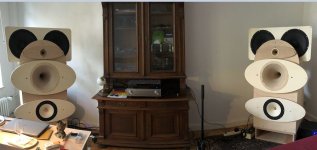
And then some fotos of the construction details:
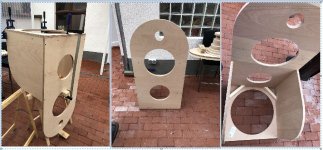

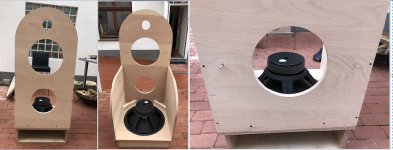
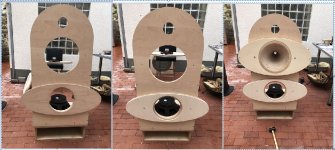
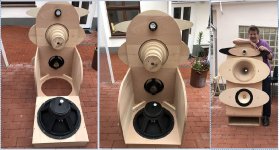
Last but not least the first measerument without the mickymouse ears kickbass and Visaton TL16H supertweeter replaced with see actual specs below
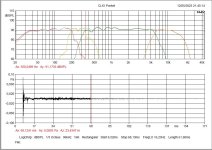
Very quick some tech specs
Subwoofer 21 inch HSB21
miniDSP active CO BP LR4 10 Hz - 85 Hz
power amp Crown XLi 800 bridged mode
Kickbass 2 X 15 inch Celestion FTR15-3070C
miniDSP active CO BP LR4 85 Hz - 170 Hz
power amp Crown XLi 800 parallel mode
Midbass 12 inch Sonido custom chassis
Plate amp Hypex FA 123 CH1 active CO BP LR4 170 Hz - 340 Hz
Midhorn Tractrix Curve Woodhorn 16 inch with B & C DCM 414 compression driver
Plate amp Hypex FA 123 CH2 active CO BP LR4 340 Hz - 3400 Hz
Tweeterhorn Tractrix Curve Woodhorn 5 inch with 18sound NSD1095N compression driver
Plate amp Hypex FA 123 HF CH active CO HP LR4 3400 Hz
I would like to offer a short presentation of my latest slot loaded open baffle project in ongoing development. Here the latest version with the strange mickymouse ears for the kickbass:

And then some fotos of the construction details:





Last but not least the first measerument without the mickymouse ears kickbass and Visaton TL16H supertweeter replaced with see actual specs below

Very quick some tech specs
Subwoofer 21 inch HSB21
miniDSP active CO BP LR4 10 Hz - 85 Hz
power amp Crown XLi 800 bridged mode
Kickbass 2 X 15 inch Celestion FTR15-3070C
miniDSP active CO BP LR4 85 Hz - 170 Hz
power amp Crown XLi 800 parallel mode
Midbass 12 inch Sonido custom chassis
Plate amp Hypex FA 123 CH1 active CO BP LR4 170 Hz - 340 Hz
Midhorn Tractrix Curve Woodhorn 16 inch with B & C DCM 414 compression driver
Plate amp Hypex FA 123 CH2 active CO BP LR4 340 Hz - 3400 Hz
Tweeterhorn Tractrix Curve Woodhorn 5 inch with 18sound NSD1095N compression driver
Plate amp Hypex FA 123 HF CH active CO HP LR4 3400 Hz
Last edited:
Not exactly sure where to post this as it covers a number of technologies.
General purpose guitar/streaming amp
Wild Burro's Betsy driver.
One inch dome tweeter
Open box (infinite baffle)
ADU1710 DSP
Sigma Studio auto equalized in room.
DSP crossovers at 5,000 Hz
Pretty flat from 30 Hz to 20Khz.
Fosi Vacuum tube pre-amplifier with Class D power amp.
One amp per driver.
Very clean detailed sound with no boom at lower frequencies.


General purpose guitar/streaming amp
Wild Burro's Betsy driver.
One inch dome tweeter
Open box (infinite baffle)
ADU1710 DSP
Sigma Studio auto equalized in room.
DSP crossovers at 5,000 Hz
Pretty flat from 30 Hz to 20Khz.
Fosi Vacuum tube pre-amplifier with Class D power amp.
One amp per driver.
Very clean detailed sound with no boom at lower frequencies.
- Home
- Loudspeakers
- Multi-Way
- Ultimate Open Baffle Gallery
